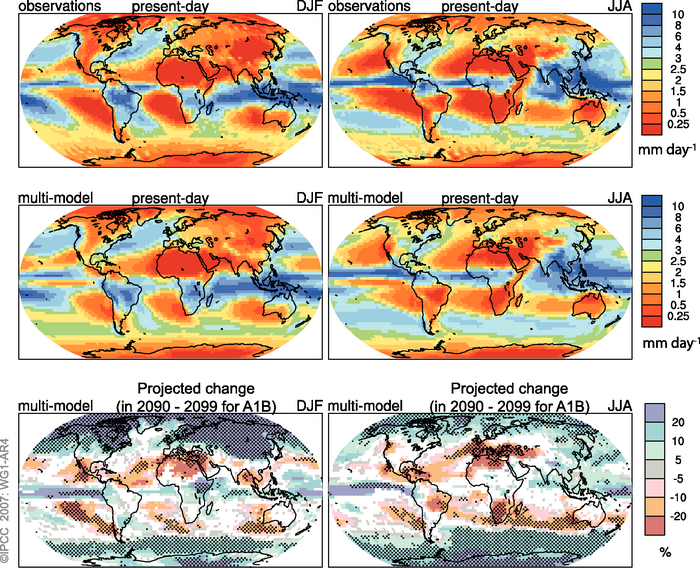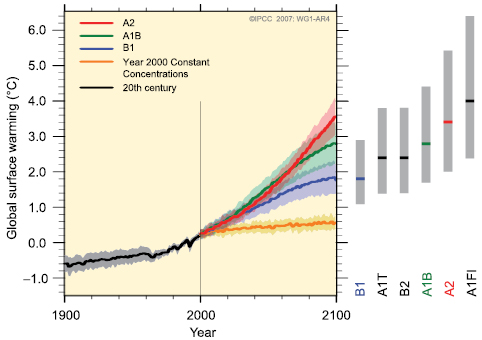You’ve probably heard of supermodels like Heidi Klum and Kate Moss, but have you heard of SUMO? It’s an abbreviation for a project called Super Modeling by Combining Imperfect Models, and although it doesn’t sound nearly as glamorous, it may mean big things for climate modeling. This innovative approach, pioneered by an interdisciplinary group of scientists from around the world, seeks to build on the success achieved by using the mean of an ensemble of different climate models to predict future climate change. Instead of running the models independently and averaging them after the fact, SUMO has developed a framework to couple models interactively during a simulation. This might not seem like a big change, but it represents a tremendous technical challenge, one that might prove well worth the effort if the project achieves its ambitious aims. So far, the results look promising.

This figure from the Intergovernmental Panel on Climate Change 4th Assessment Report released in 2007 shows predicted changes in regional precipitation patterns associated with climate change using the mean of an ensemble of state of the art climate models. Source: IPCC.
To estimate the effects of anthropogenic climate change, researchers use complex mathematical models to simulate the behavior of the Earth’s climate system. These models are based on a handful of fundamental physics equations – like conservation of momentum, energy, and mass – and they overwhelmingly agree on the general direction of changes we can expect to see (for example, they unanimously project that global average temperature will rise). However, individual models produce markedly different estimates of the amplitude of future warming, the regional pattern of precipitation changes, and the sensitivity of global temperature to atmospheric CO2 concentrations. These discrepancies arise from differences in model architecture and most importantly, from the ways each model accounts for processes that cannot be simulated organically in the model because they operate on scales too small to be captured, or because they require additional physics.

State of the art models disagree about the magnitude of future warming. The colored lines represent different emissions scenarios while the grey error bars on the right show the spread between models. Source: IPCC.
Researchers have long noted that the best way to synthesise these disparate results is to take the average of a group of climate models. This approach generally provides the best match to empirical observations, and the spread between models provides a useful measure of model uncertainty. While the success of averaging might seem lucky, or even coincidental, many scientists say it isn’t all that surprising. After all, people don’t pick values for important model coefficients out of thin air; they spend a great deal of time trying to choose optimal numbers by “training” the models on observational data and by using outside constraints for the most likely value of a parameter. “It’s like one of those games at the fair where you have to guess the number of balls in a jar,” says Dr. Win Wiegerinck, a machine learning specialist at Radboud University Nijmegen in Holland who presented early results of the SUMO project at the EGU General Assembly on Monday. “If you take the average of many people’s guesses, you often get the right answer.”
Based on this idea, Wiegerinck and his colleagues at the SUMO project are taking averaging to the next level. At every time step of a multi-model simulation, they require the models to agree on an intermediate result, essentially binding every model to the instantaneous mean. “If conventional model-mean studies use a coupling of zero,” says Wiegerinck to put things in sufficiently quantitative parlance for the EGU crowd, “SUMO represents setting the coupling between models to infinity.” He notes that it is possible to use any degree of coupling between these two extremes and in their initial experiments, the SUMO group has experimented with partially and fully coupled model ensembles. The benefit of this new approach is that it might prevent models from diverging dramatically due to cumulative errors that would grow during independent model runs. Their hope is that it will also provide the best way of simulating reality.

The Lorenz Attractor is a set of differential equations that illustrates the so-called “butterfly effect” in which the occurrence of a significant event (like a hurricane) might depend on whether or not something seemingly inconsequential happened before (like a buttefly flapping its wings). The solution of the Lorenz Attractor depends strongly on the initial values and, coincidentally, looks a bit like a butterfly itself. Source: Wikimedia Commons.
SUMO brings together experts in climate science, nonlinear dynamical systems, and machine learning, like Wiegerinck, to tackle the considerable challenge of coupling many complex models. As a preliminary test, they modeled a simple chaotic system like the famous Lorenz attractor. It seemed like a good prologue to climate modeling, because like the global climate system, the Lorenz equations depend strongly on small differences in initial conditions that can lead to drastically different solutions. After passing this test, SUMO embarked on an experiment with a simplified atmospheric circulation model.
In this first attempt, the coupled and ensemble-mean models performed better than any individual model at simulating northern hemisphere circulation, as expected. In addition, SUMO performed as well as the traditional model-mean approach in simulating the average climate state, a sign that the researchers are on the right track. The coupled models also did a bit better than the ensemble mean at simulating the correct degree of variability, an achievement just as important as getting the absolute value correct in a climate model. These results are encouraging, although the scientists stress that it is too early to know whether or not SUMO will be up to the long-term goal of predicting climate using complex models like the ones employed by the Intergovernmental Panel of Climate Change Assessment Reports to advise policymakers around the world on the expected impacts of climate change.
The researchers are nonetheless optimistic about short-range predictions. Dr. Frank Selten of the Royal Netherlands Meteorological Institute who oversees the climate science branch of SUMO thinks coupled models could be very useful for sub-annual forecasts. He says they have the potential “to reduce the contribution of model error to the prediction error [and] to estimate the reliability of the forecast.” In any case, SUMO represents a novel approach to climate modeling, and one to keep an eye on as it progresses towards integrating increasingly complex models. Based on the solid first results shown here at EGU, it looks like SUMO may indeed have something in common with those other supermodels: it might just be onto the next big trend.
By Julia Rosen, Freelance science writer and PhD student in Earth, Ocean, and Atmospheric Sciences at Oregon State University


John Rehm
I wish someone would work in the science of spores and vegetative indications of global warming. Erling Dorf of Princeton University was an expert in the field, but he is gone now. I miss his point of view. He did a lot of work on Quaternary climate trends.